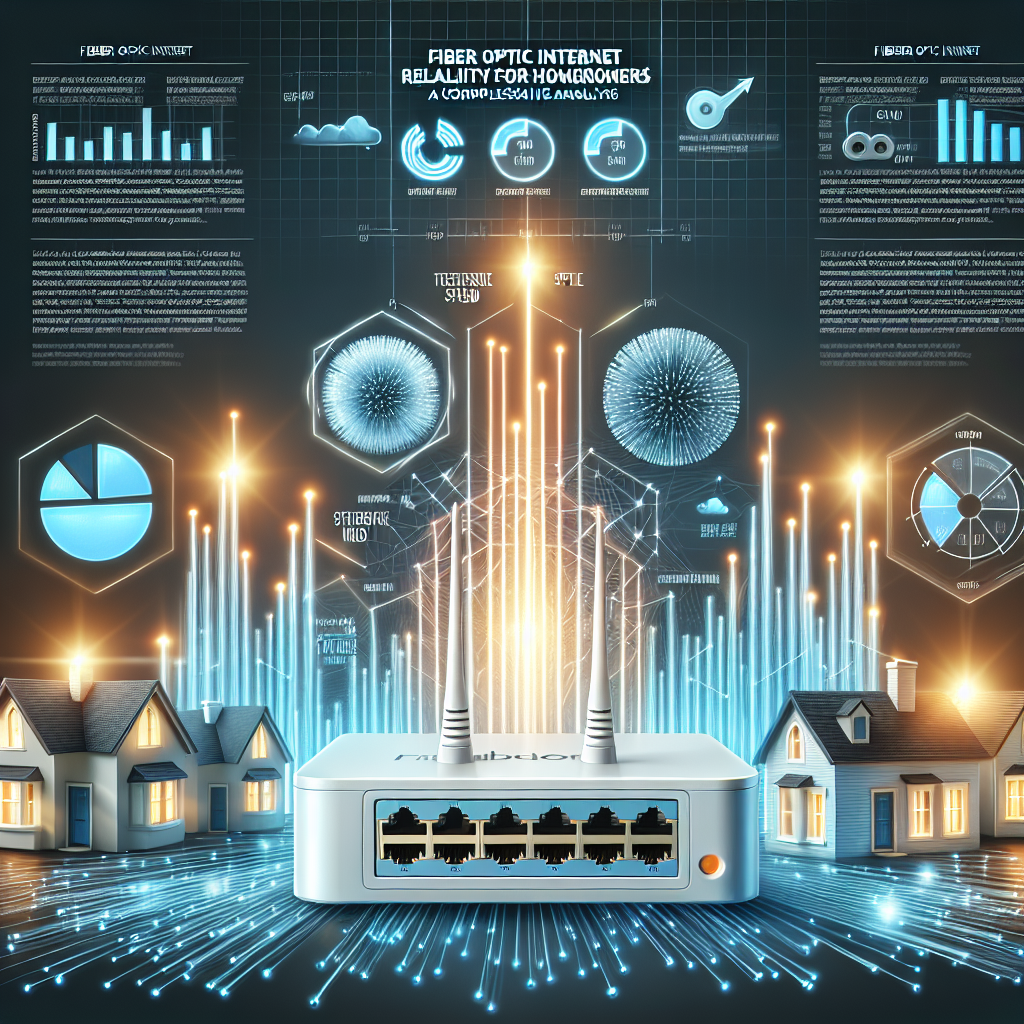In today’s digital age, reliable internet connection is paramount for homeowners. Fiber optic internet is widely recognized for its superior speed and stability, making it an ideal choice for those looking for consistent connectivity. This comprehensive analysis delves into the various factors that contribute to the reliability of fiber optic internet for homeowners. From its advanced technology to its ability to withstand environmental factors, fiber optic internet sets itself apart from traditional broadband options. Discover how investing in fiber optic internet can ensure a seamless online experience for you and your family.
Understanding Fiber Optic Internet Reliability

What is Fiber Optic Internet?
Understanding Fiber Optic Internet Reliability
Fiber optic internet is a type of internet connection that utilizes fiber optic cables to transmit data at high speeds. Unlike traditional copper cables, fiber optic cables are made of thin strands of glass or plastic that transmit data using light signals. This technology allows for faster and more reliable internet connections compared to DSL or cable internet.
Definition and basic concept
- Fiber optic internet refers to a connection that utilizes fiber optic cables to transmit data.
- The basic concept involves sending data through light signals that travel along the fiber optic cables.
How fiber optic internet works
- Fiber optic internet works by converting data into light signals that are sent through the fiber optic cables.
- These light signals travel at incredibly high speeds, allowing for faster data transmission.
- At the receiving end, the light signals are converted back into data that can be accessed by the user.
- This process results in a more reliable internet connection with minimal interference and faster speeds compared to traditional internet connections.
Reliability of Fiber Optic Internet
Fiber optic internet is known for its exceptional reliability, making it a popular choice for homeowners looking for a stable and consistent internet connection. The reliability of fiber optic internet can be attributed to several key factors, setting it apart from other types of internet connections.
Factors that contribute to reliability:
-
Physical stability: Fiber optic cables are made of glass or plastic fibers that are highly durable and less prone to damage from environmental factors such as inclement weather or electromagnetic interference. This physical stability ensures that the internet connection remains steady and reliable even in challenging conditions.
-
Minimal signal loss: Fiber optic cables transmit data using light signals, which experience minimal loss over long distances compared to traditional copper cables. This means that homeowners can enjoy consistent internet speeds without experiencing significant drops or fluctuations in connectivity.
-
Symmetrical upload and download speeds: Fiber optic internet offers symmetrical upload and download speeds, ensuring that users can send and receive data at the same high speeds. This balance in speeds contributes to the overall reliability of the internet connection, allowing for smooth and uninterrupted online activities.
Comparison with other types of internet connections:
-
Superior to DSL and cable: Fiber optic internet surpasses DSL and cable connections in terms of reliability due to its use of light signals that are less susceptible to interference or degradation. This results in a more stable and dependable internet connection for homeowners.
-
Less prone to congestion: Unlike traditional internet connections that rely on shared bandwidth, fiber optic internet provides dedicated lines to each household. This dedicated connection minimizes the risk of network congestion, ensuring consistent speeds and reliable performance even during peak usage hours.
-
Lower latency: Fiber optic internet offers lower latency or lag times compared to other types of connections, enhancing the overall reliability of the network for activities such as online gaming, video streaming, and video conferencing. The reduced latency ensures a smoother and more responsive online experience for homeowners.

Benefits of Fiber Optic Internet Reliability
Enhanced Stability and Consistency
Benefits of Fiber Optic Internet Reliability
Fiber optic internet reliability offers homeowners a level of stability and consistency that surpasses traditional internet options. This enhanced reliability is attributed to the advanced technology and infrastructure of fiber optic networks.
-
Low latency and minimal signal interference: Fiber optic cables transmit data using light pulses, resulting in significantly lower latency compared to copper wiring. This means that data travels at near-light speeds, reducing delays and ensuring a smoother online experience for homeowners. Additionally, fiber optics are immune to electromagnetic interference, which can degrade signal quality in traditional copper-based networks.
-
Redundancy in fiber optic networks: Fiber optic networks are built with redundant pathways, meaning that if one pathway is compromised or experiences issues, data can be rerouted through alternative pathways seamlessly. This redundancy feature enhances the reliability of fiber optic internet connections, ensuring that homeowners have consistent access to high-speed internet without disruptions.
Faster Speeds and Bandwidth
fits of Fiber Optic Internet Reliability
-
Impact on streaming: Fiber optic internet reliability ensures smooth and uninterrupted streaming of high-definition content on platforms like Netflix, Hulu, and YouTube. With a reliable connection, homeowners can enjoy their favorite shows and movies without buffering or lagging issues. This is particularly crucial for households with multiple devices streaming simultaneously.
-
Gaming performance: Fiber optic internet’s reliability translates to low latency and high speeds, which are essential for online gaming. Gamers can experience seamless gameplay, quick response times, and minimal interruptions due to a stable connection. This can make a significant difference in competitive gaming scenarios where split-second decisions matter.
-
Large file downloads: Homeowners often need to download large files for work, school, or personal projects. Fiber optic internet’s reliability ensures that these downloads are completed quickly and efficiently. Whether it’s downloading software updates, multimedia files, or important documents, a reliable fiber connection can significantly reduce wait times and boost productivity.
-
How reliability affects overall internet performance: The reliability of fiber optic internet directly impacts the overall performance of a homeowner’s internet connection. Consistent uptime and minimal outages mean that individuals can rely on their internet for work, communication, entertainment, and other online activities. This reliability fosters a seamless online experience, preventing frustrations caused by dropped connections or slow speeds.
Common Misconceptions about Fiber Optic Internet Reliability
Myth: Fiber Optic Internet is Prone to Outages
Common Misconceptions about Fiber Optic Internet Reliability
Fiber optic internet is often perceived as being prone to outages, leading to doubts about its reliability among homeowners. However, a closer examination of this myth reveals a more nuanced reality.
- Exploring the myth and its origins:
- The misconception that fiber optic internet is prone to outages may stem from the unfamiliarity with this technology compared to traditional copper wiring.
-
Misinformation or anecdotal experiences of outages with fiber optic internet services could have contributed to the perpetuation of this myth.
-
Real-world data on outage frequency:
- Contrary to popular belief, fiber optic internet is known for its reliability due to its resistance to interference and signal degradation.
- Statistical analysis of outage frequency for fiber optic networks often demonstrates lower rates of downtime compared to cable or DSL connections.
- Studies have shown that fiber optic infrastructure is more robust and less susceptible to environmental factors that can cause service interruptions.
Myth: Fiber Optic Internet Reliability Depends Solely on Provider
When it comes to the reliability of fiber optic internet, there is a common misconception that it is entirely dependent on the service provider. However, this myth fails to consider the multifaceted nature of maintaining a stable internet connection through fiber optics. Let’s delve deeper into the factors that challenge this misconception:
-
Understanding the role of infrastructure and maintenance:
- Fiber optic internet reliability is not solely determined by the provider, but also by the quality of the infrastructure in place. The fiber optic cables that deliver high-speed internet to homes require proper installation and regular maintenance to ensure optimal performance. Issues such as cable damage, signal interference, or outdated equipment can significantly impact reliability, regardless of the provider’s reputation.
- Homeowners should be aware of the importance of infrastructure quality and invest in proper installation practices to support reliable fiber optic internet. This may involve working with certified technicians, using high-quality equipment, and conducting periodic inspections to identify and address any potential issues proactively.
-
Consumer responsibilities for maintaining reliability:
- While the service provider plays a crucial role in delivering fiber optic internet, homeowners also have a responsibility to maintain reliability on their end. This includes safeguarding the internal network setup, ensuring appropriate modem and router configurations, and implementing security measures to prevent unauthorized access or cyber threats.
- Neglecting these consumer responsibilities can lead to connectivity issues and compromise the overall reliability of fiber optic internet services. By staying proactive and informed about best practices for network management, homeowners can contribute to a more stable and secure internet experience.
In conclusion, the reliability of fiber optic internet for homeowners is influenced by a combination of factors beyond the service provider, emphasizing the importance of understanding infrastructure requirements and fulfilling consumer responsibilities to ensure consistent connectivity and performance.
Ensuring Fiber Optic Internet Reliability at Home
Proper Installation and Setup
Ensuring Fiber Optic Internet Reliability at Home
Proper installation and setup of fiber optic internet are crucial for ensuring optimal performance and reliability in a homeowner’s network. Here are some key considerations to keep in mind:
- Importance of Professional Installation
When it comes to fiber optic internet, professional installation is highly recommended. Fiber optic cables are delicate and require precise handling to avoid damage. A professional installer has the expertise and tools needed to ensure that the cables are installed correctly and securely. Improper installation can lead to signal loss, affecting the speed and reliability of the internet connection.
-
Tips for Optimizing Home Network Setup
-
Placement of Equipment: Positioning the fiber optic modem and router in a central location within the home can help ensure better coverage and signal strength throughout the house.
-
Use Quality Equipment: Investing in high-quality routers and networking equipment can contribute to a more stable and reliable connection. Make sure the devices are compatible with fiber optic technology for optimal performance.
-
Secure Connections: Ensuring that all connections between devices are secure and free from interference can help maintain a consistent internet connection. Avoid overcrowding the area around the router with other electronic devices that may cause signal interference.
-
Regular Maintenance: Periodically checking and maintaining the fiber optic equipment can help prevent potential issues before they impact internet reliability. This includes inspecting cables for any wear or damage and ensuring that all connections are secure.
By following these tips and considering the importance of professional installation, homeowners can help maximize the reliability of their fiber optic internet connection.
Regular Maintenance and Troubleshooting
Maintaining the reliability of fiber optic internet at home requires proactive measures to prevent and address potential issues. By implementing regular maintenance and troubleshooting practices, homeowners can ensure a seamless online experience. Here are some key strategies to consider:
- DIY Troubleshooting for Common Issues
When encountering connectivity issues, homeowners can perform initial troubleshooting steps before seeking professional help. Common problems such as slow internet speeds, intermittent connections, or signal loss can often be resolved through simple actions. These may include restarting the router, checking cable connections, or resetting the modem. By familiarizing themselves with basic troubleshooting techniques, homeowners can quickly identify and address minor issues without delay.
- When to Seek Professional Assistance for Maintenance

While DIY troubleshooting can resolve many common fiber optic internet issues, there are instances where professional assistance may be necessary. If problems persist despite initial troubleshooting efforts, or if homeowners are unfamiliar with complex network configurations, it may be time to consult with a qualified technician. Professional maintenance services can help diagnose underlying issues, conduct thorough system checks, and implement advanced solutions to ensure the long-term reliability of fiber optic internet connections at home.
Future Trends in Fiber Optic Internet Reliability
Advancements in Fiber Optic Technology
Recent advancements in fiber optic technology have shown promising potential for improving the reliability and performance of internet connections for homeowners. These advancements are crucial in meeting the increasing demand for high-speed and stable internet access. Here are some key points to consider:
-
Enhanced Signal Quality: New developments in fiber optic cables, such as tighter core tolerances and improved manufacturing processes, contribute to better signal quality. This results in reduced signal loss and improved reliability, especially over long distances.
-
Increased Bandwidth Capacity: Upgrades in fiber optic infrastructure have led to a significant increase in bandwidth capacity. This means that homeowners can enjoy faster internet speeds without compromising reliability, even during peak usage times.
-
Advanced Network Monitoring: The integration of sophisticated monitoring systems allows for real-time network performance analysis. By proactively identifying and addressing potential issues, service providers can ensure a more reliable internet connection for homeowners.
-
Resilience to Interference: Fiber optic technology is inherently less susceptible to electromagnetic interference compared to traditional copper wiring. This resilience ensures a more stable internet connection, even in environments with high levels of electromagnetic activity.
-
Deployment of Redundant Pathways: To enhance reliability, fiber optic networks are increasingly being designed with redundant pathways. In the event of a cable cut or other network disruptions, traffic can be rerouted efficiently, minimizing downtime for homeowners.
These advancements in fiber optic technology not only improve the reliability of internet connections but also pave the way for future innovations that will further enhance the user experience for homeowners.
Consumer Expectations and Industry Standards
Consumer expectations for internet reliability have evolved significantly in recent years due to the increasing reliance on digital connectivity for work, entertainment, and communication. Homeowners now expect seamless and uninterrupted internet access to support their daily activities. As a result, the industry is under pressure to meet these heightened expectations and deliver reliable fiber optic internet services.
Shifting Expectations for Internet Reliability
- Homeowners expect consistent high-speed internet connectivity for streaming, online gaming, video conferencing, and other bandwidth-intensive activities.
- Reliability is no longer just about connection speed but also about uptime, latency, and overall network stability.
- Downtime or service interruptions are increasingly viewed as unacceptable by consumers, driving the demand for more reliable fiber optic internet services.
Regulatory Developments in the Fiber Optic Industry
- Regulatory bodies are recognizing the importance of internet reliability in consumers’ lives and are implementing standards to ensure service quality.
- Industry standards for fiber optic internet reliability are being established to protect consumers and promote fair competition among service providers.
- Compliance with these standards is becoming a key differentiator for internet service providers, influencing consumer choices and shaping the competitive landscape in the industry.
FAQs: Fiber Optic Internet Reliability for Homeowners
Is fiber optic internet more reliable than traditional cable or DSL internet for homeowners?
Fiber optic internet is generally considered more reliable than traditional cable or DSL internet for homeowners. This is because fiber optic cables are made of glass and are less susceptible to interference and signal degradation compared to copper cables used in traditional internet connections. As a result, fiber optic internet experiences less downtime and provides a more stable and consistent connection for homeowners.
How does fiber optic internet reliability compare to other types of internet connections during severe weather conditions?
Fiber optic internet tends to perform better during severe weather conditions compared to traditional cable or DSL internet. This is because fiber optic cables are less vulnerable to inclement weather such as rain, snow, or high winds. While severe weather can still potentially disrupt all types of internet connections, fiber optic internet is generally more resilient and less likely to experience outages or slowdowns during adverse weather.
Can I trust fiber optic internet to provide a reliable connection for important tasks like working from home or streaming content?
Yes, homeowners can trust fiber optic internet to provide a reliable connection for important tasks such as working from home, video conferencing, or streaming content. Fiber optic internet offers faster speeds, lower latency, and higher bandwidth compared to traditional internet connections, making it well-suited for demanding tasks that require a stable and consistent connection. Homeowners can rely on fiber optic internet to support their online activities without experiencing frequent interruptions or slowdowns.
